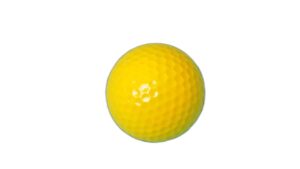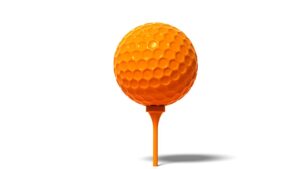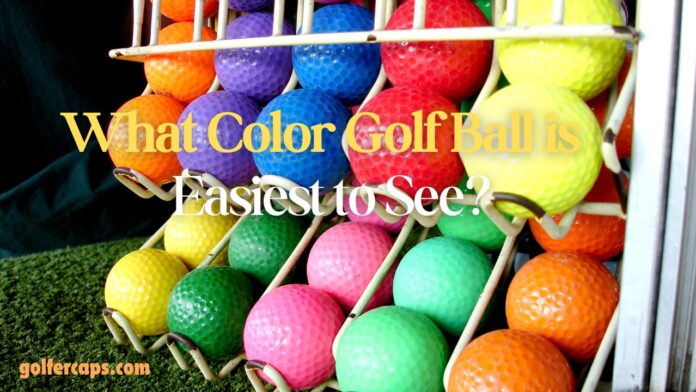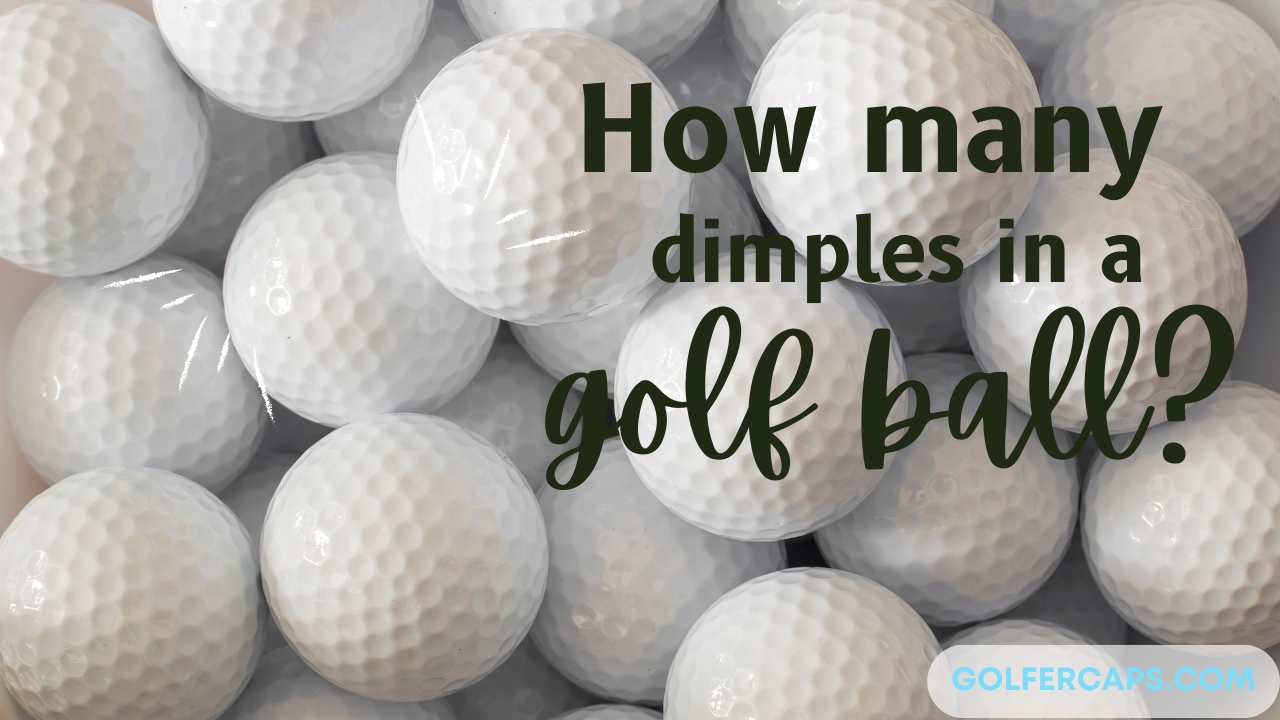Ever lose track of your golf ball mid-flight? Frustrating. Choosing the right color golf ball can save you from that headache. Whether you’re a newbie or a seasoned pro, the color of your golf ball significantly impacts how easily you can spot it on the course. Let’s dive into the factors that make certain golf ball colors more visible and find out which color might be the easiest to see for you.
Understanding Golf Ball Visibility
Factors Influencing Visibility
Lighting Conditions: The time of day and the quality of light can dramatically affect how well you see your golf ball. Bright sunlight, overcast skies, or the dim light of dawn and dusk all play roles in visibility.
Background Environment: The color of the grass, sand, or water around your ball can either help it stand out or blend in.
Player’s Vision: Individual differences in eyesight, including conditions like color blindness, can influence how well different colors are seen.
What golf ball is easy to see?
There are two factors to consider when choosing a golf ball for easy visibility: color and lighting conditions.
-
Color: In general, brighter colors are easier to see against various backgrounds. Here are some of the most visible golf ball colors:
- Yellow:Scientifically, yellow is the most visible color to the human eye in daylight. This is why it’s used for safety vests and construction site gear .
- Orange: Similar to yellow, orange is another high-visibility color that stands out well on the course.
- Other bright colors: Some golfers prefer other bright colors like pink or green, depending on their personal preference and the course conditions.
-
Lighting conditions: The same ball can appear differently depending on the time of day and weather. Here’s a quick guide:
- Bright, sunny day: Yellow or white balls are typically easiest to see.
- Overcast or low-light conditions: Brighter colors like orange or pink might be more visible.
Here are some additional tips for choosing an easy-to-see golf ball:
- Consider trying a matte finish ball: Glossy finishes can reflect sunlight and be harder to see in certain conditions.
- Look for balls with high visibility technology: Some manufacturers have developed balls with special coatings or designs that are supposed to be easier to see.
Ultimately, the best way to find the easiest golf ball to see is to experiment with different colors and see what works best for you in different lighting conditions.
Choosing the Right Color for Your Game

Choosing the right color golf ball can make a significant difference in your game. Here are the top 10 tips to help you select the most visible and effective color for your golfing needs.
1. Consider Lighting Conditions
The lighting on the course can change throughout the day. Bright sunlight, overcast skies, and twilight can all impact how well you see your ball.
- Sunny Days: Neon yellow and bright orange are excellent for sunny conditions.
- Overcast Days: White and neon yellow work well in diffuse light.
- Low Light: Bright orange and neon yellow stand out best during dawn and dusk.
2. Evaluate the Background Environment
The environment where you play most often will influence your choice. Consider the typical backgrounds:
- Green Grass: Neon yellow and bright orange provide high contrast.
- Sand Traps: Bright colors like orange and pink stand out against sand.
- Water Hazards: Neon yellow is highly visible near water.
3. Test Different Colors in Practice
Before committing to a specific color, test different options during your practice rounds. See which colors are easiest for you to spot under various conditions.
4. Account for Personal Vision
Your unique vision plays a big role in visibility. If you have any vision impairments, choose colors that compensate for these:
- Color Blindness: Neon yellow and bright orange are generally good choices.
- Aging Eyes: Brighter, high-contrast colors are easier to see.
5. Switch Colors Based on Weather Conditions
Don’t stick to just one color. Adapt your choice to the day’s weather:
- Clear Days: Opt for neon yellow or bright orange.
- Cloudy Days: White or neon yellow might be better.
6. Use High-Visibility Patterns
Some golf balls feature patterns designed for better visibility. These can be especially useful if you struggle with spotting single-colored balls.
7. Get Feedback from Playing Partners
Sometimes your playing partners can offer valuable insights. Ask them which colors they notice you struggle with and which ones you seem to spot easily.
8. Consider the Season
The time of year can affect visibility. For instance, bright orange balls are great during autumn when leaves are on the ground.
9. Have Multiple Colors on Hand
Keep a variety of colored balls in your bag. This way, you can switch colors based on changing conditions during your round.
10. Prioritize Contrast Over Personal Preference
While it’s great to have a favorite color, prioritize visibility and contrast over aesthetics. The goal is to reduce time spent searching for your ball, keeping your focus on the game.
Read also: Do Golf Balls Go Bad in Water?
Popular Golf Ball Colors
Traditional White

Pros: White golf balls are the classic choice and are generally easy to spot against the green grass. They’re also the standard in professional play.
Cons: They can get lost easily in the snow or among white flowers on the course.
Neon Yellow

Pros: Neon yellow is one of the most visible colors in various conditions. It stands out well against both green grass and blue sky.
Cons: It might not be as effective in very bright sunlight, where it can blend with the surroundings.
Bright Orange

Pros: Bright orange balls are great for visibility against green grass and in autumn when leaves fall.
Cons: They can be harder to spot in the sand and sometimes blend with autumn leaves.
Other Colors (Pink, Green, Multi-Colored)

Pros: Colors like pink and green can offer good visibility, especially if you have a personal preference. Multi-colored balls can be fun and may help in certain conditions.
Cons: They may not always provide the highest contrast, depending on the background.
Read also: Do Golf Balls Expire?
The Science Behind Golf Ball Colors
Understanding the science behind golf ball colors can help you choose the most visible and effective color for your game. Here are the top 10 insights that will guide you in making the best choice.
1. Contrast and Background
Contrast is crucial for visibility. A golf ball that contrasts sharply with its surroundings is easier to see. Bright colors like neon yellow and bright orange provide high contrast against green grass and blue sky, making them stand out more than traditional white balls.
2. Human Eye Sensitivity
The human eye is particularly sensitive to certain colors. Yellow and green hues are more easily detected by our eyes because they fall in the middle of the visible spectrum. This makes neon yellow an excellent choice for maximum visibility.
3. Color Vision Deficiencies
People with color vision deficiencies, such as red-green color blindness, may struggle to distinguish certain colors. For these individuals, colors like neon yellow and bright orange, which are outside the problematic red-green spectrum, are easier to see.
4. Lighting Conditions
The time of day and weather conditions affect visibility.
- Sunny Days: Neon yellow and bright orange balls provide the best visibility in bright sunlight.
- Overcast Days: White and neon yellow balls are more visible in diffuse light conditions.
- Low Light: Neon yellow and bright orange are also effective in low light conditions, such as dawn and dusk.
5. Age and Vision Changes
As we age, our eyes change, affecting color perception. The lens of the eye can yellow, and pupil size decreases, leading to less light entering the eye. Older golfers might find bright, high-contrast colors like neon yellow and bright orange easier to see.
6. Environmental Considerations
Different playing environments require different color considerations.
- Grass and Fairways: Neon yellow and bright orange balls stand out well against the green backdrop.
- Sand Traps and Bunkers: Bright colors like orange and pink contrast sharply with the beige or white sand.
- Water Hazards: Neon yellow is highly visible near water hazards, contrasting well against the blue and green hues of water and surrounding grass.
7. Weather Adaptability
Weather conditions can change throughout your game, affecting which color is most visible. Having a variety of colors available can help you adapt to changing conditions. For instance, a bright orange ball might be best in autumn when leaves cover the ground, while neon yellow might be better in spring and summer.
8. Testing Different Colors
Testing various colors during practice rounds can help determine which ones are easiest for you to spot. Pay attention to how different colors perform under various lighting and environmental conditions.
9. High-Visibility Patterns
Some golf balls feature patterns designed for better visibility. These patterns can make the ball easier to track, especially if you have difficulty seeing single-colored balls.
10. Personal Preference and Comfort
Ultimately, personal preference and comfort play significant roles in choosing the right color. While scientific principles are helpful, the best color is the one that you find easiest to see and track during your game. Don’t hesitate to experiment with different colors to find your perfect match.
Read also: How Many Golf Balls Are in a Box?
Visibility in Different Weather Conditions
Sunny Days
Best Colors for Clear Weather: Neon yellow and bright orange are typically the best for clear, sunny days. They provide a strong contrast against the blue sky and green grass.
Overcast Days
Best Colors for Cloudy Weather: On overcast days, white and neon yellow balls usually stand out more as the light is diffused and less harsh.
Low Light Conditions (Dawn/Dusk)
Best Colors for Low Light: In dim light conditions, neon yellow and bright orange balls are easier to see. These colors tend to stand out even when the light is not ideal.
Visibility in Different Playing Environments
Grass and Fairways
Colors that Stand Out on Green Backgrounds: Neon yellow and bright orange are excellent choices as they contrast well with green.
Sand Traps and Bunkers
Colors that Stand Out in Sand: Bright colors like orange and pink are best in sand traps, as they contrast sharply with beige or white sand.
Water Hazards
Colors that Stand Out Near Water: Neon yellow is highly visible near water hazards, as it contrasts well against the blue and green of water and surrounding grass.
Personal Preferences and Visual Acuity
How Age Affects Color Perception
As we age, our eyes can become less sensitive to certain colors. This makes choosing a high-contrast color even more important.
Impact of Eye Health on Color Visibility
Eye health conditions like cataracts or macular degeneration can affect color perception. In such cases, brighter and more contrasting colors are beneficial.
Conclusion
Choosing the right color golf ball can make a significant difference in your game. It helps reduce frustration and can even improve your performance by keeping your focus where it belongs. Neon yellow and bright orange often come out on top for visibility across a range of conditions, but your personal preferences and vision will ultimately guide your best choice. Try out a few colors and see which works best for you.
FAQs:
1. What is the best color golf ball for beginners?
Neon yellow is often recommended for beginners due to its high visibility in various conditions.
2. Are there any golf balls designed specifically for visibility brands offer golf balls specifically designed for enhanced visibility, featuring bright colors and high-contrast patterns.
3. How do I know if a golf ball color suits me?
Test different colors during your practice rounds to see which is easiest for you to track.
4. Can weather conditions change the best color choice?
Absolutely. Bright sunlight, overcast skies, and low light conditions can all affect which color is most visible.
5. Are multi-colored golf balls more visible than single-color balls?
Multi-colored balls can be more visible in certain conditions, but it often depends on the specific colors and patterns used.











